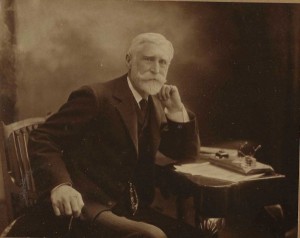‘This extraordinary combination of rogues and fools’— newspaper coverage of the Rising
Published in Editorial, Issue 1 (January/February 2015), Volume 23
William Martin Murphy, owner of the Irish Independent and the Irish Catholic. Both were violently opposed to the Rising.
In the early twentieth century, the newspapers they read defined Irish people. The Anglo-Irish establishment read the Irish Unionist Irish Times. When the Irish Parliamentary Party (IPP) split over Parnell’s relationship with Katherine O’Shea, the paper’s readership split as well. While the Freeman’s Journal went with the majority in opposing Parnell, a minority moved to read the Irish Independent. Abbey Street was the street for mainstream newspapers in Dublin.
The Freeman’s Journal was the most conservative, Catholic and anti-Parnellite of popular newspapers. Nevertheless, it was the only newspaper that seemed to accept that responsibility for the riots associated with the Lockout of 1913 could not be laid primarily on the shoulders of Dublin’s hooligan element or its socialists. The Freeman’s Journal was considered the voice of the decidedly non-revolutionary United Irish League and of John Redmond’s IPP. It accepted Home Rule as it was proposed in parliament. Its circulation dropped greatly and it became a weekly after Redmond’s recruiting speech to parliament in 1914.
The Irish Independent, owned by William Martin Murphy, tried to break the Irish Transport and General Workers’ Union strike of 1913 and the union itself, and it advocated full dominion status for Ireland after the 1916 Rising. It called for the execution of the leaders of the Rising and was especially hard on James Connolly. The following appeared in its editorials of 4 and 10 May:
‘No terms of denunciation that pen would indict would be too strong to apply to those responsible for the criminal and insane rising of last week.’ (4 May)
‘If these men are treated with too great leniency they will take it as an indication of weakness on the part of the government and the consequences may not be satisfactory . . . Let the worst of the ringleaders be singled out and dealt with as they deserve.’ (10 May)
The Irish Times was a unionist newspaper. On the Tuesday morning of Easter Week, it described the Rising:
‘This newspaper has never been published in stranger circumstances than those that obtain today, an attempt to overthrow the government of Ireland . . . At this critical moment our language must be moderate, unsensational, and free from any tendency to alarm. As soon as peace and order have been restored the responsibility for the intended revolution will be fixed in the right quarter . . .’
After the Rising, the Irish Times reported of Pearse that
‘. . . his audience became progressively bored . . . On a rumour that [Clery’s was going to be breached for looting] his audience moved over to the shop windows, and left the speaker finishing his peroration with no one to listen to him but his guard. Like the revolution itself, the proclamation was a fiasco.’
The Irish Catholic, located at 55 Middle Abbey Street, was another newspaper owned by William Martin Murphy. It was violently opposed to the Irish Citizen Army and the Volunteers, as was Murphy’s Irish Independent. In early May 1916, it wrote of the Rising and the leaders:
‘Pearse was a man of ill-balanced mind, if not actually insane, and the idea of selecting him as chief magistrate of the Irish Republic is quite enough to create serious doubts as to the sanity of those who approved of it . . . Only the other day when the so-called Republic of Ireland was proclaimed . . . no better President could be proposed . . . than a crazy and insolent schoolmaster. This extraordinary combination of rogues and fools . . . to find anything like a parallel for what has occurred it is necessary to have recourse to the bloodstained annals of the Paris Commune.’
Joseph E.A. Connell Jr is the author of Dublin in rebellion: a directory, 1913–1923 (Lilliput Press, 2006).
Further reading
I. Kenneally, Paper wall: newspapers and propaganda in Ireland, 1919–1921 (Cork, 2008).
















